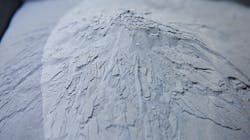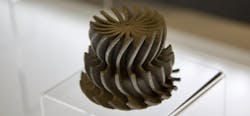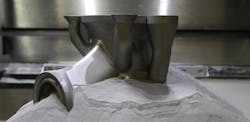Are All 3D Printed Metals the Same?
Before the commercialization of additive metal manufacturing, there were limited options for technologies that could manufacture metal components. Today, there are several different methods for manufacturing 3D printed metal components with their own strengths and limits.
Before we discuss the different additive metal processes, we review the raw materials used in additive metal systems and how they are created. Currently, raw material is available in two forms: wire and powdered metal.
Raw Materials
Powdered Metal
Powdered metal is the most commercially available metal 3D printing process today. The metal atomization method creates fine, uniform metal powder in three major steps: melting, atomization, and solidification.
In other words, elemental metal is combined in a crucible and melted, then the molten metal is poured into a jet of inert gas that blasts the liquid metal into atomized droplets. As the droplets fall, they cool and solidify, forming tiny metal spheres. The size of the spheres or particles can be 5 to 150 microns. The additive processes require specific particle sizes as the metal powder passes through a series of mesh screens, or sieves, to narrow the particle size distribution.
Spooled Metal
The most common method used to manufacture metal spooled wire is extrusion through a die. A wide variety of wire feedstock exists due to its current use in fabrication, such as maintenance and repair shops employing hand-operated MIG and TIG welding. Spooled metal has been employed for years with traditional manufacturing methods, but adaptation to additive manufacturing processes has brought it to a new market.
Depending on the process variation and base material being welded, the diameters of the spooled metal wire used in metal additive manufacturing typically range from 0.7 to 2.4 mm (0.028 to 0.095 in.) but can be as large as 4 mm (0.16 in). A larger wire will help with manufacturing speed, but a smaller diameter wire provides better accuracy. It’s important to note that spooled wire used in additive processes is only used in the metal deposition process.
Additive Metal Processes
Many additive metal system providers are using their own acronyms and names to segment their place in the additive manufacturing market, but each system can be lumped into general categories that yield similar end results. In this guide, we’ve categorized these into three overarching processes—metal deposition, bound metal, and powder bed fusion—and discuss their strengths, limits, and similarities.
Metal Deposition
Metal deposition creates geometries with either the wire-fed method or by spraying powdered metal onto a substrate in the path of a heat source such as a focused electron beam, laser, or plasma arc that melts them together. This process is also referred to as laser engineered net shaping, directed light fabrication, 3D laser cladding, and/or direct metal deposition.
In wire-feed additive manufacturing, a metal wire is used as a supply material instead of metal powder. Parts created using wire-fed metal require machining to achieve commonly acceptable tolerances since the diameter of the wire and the spray of the powder limit its resolution.
Metal deposition's primary use in the market is adding material to existing objects rather than creating new geometry. For example, metal deposition technology is used in aerospace to repair existing metal components that were expensive to create in the first place, such as engine turbine blades, or depositing expensive material locally on the existing stock to reduce the amount of material that would be machined into waste. The deposition head can be precisely controlled by a multi-axis CNC machine head or by employing an advanced robotics system.
Pros:
- Ability to repair or fabricate large parts
- Above 99% density
- Rapid material deposition
Cons:
- Depending on the exact process, the surface finish can be a pain point
- Overhanging surfaces sometimes require supporting
- High residual stresses and distortions
- Limited tolerances and a wire-fed process are even less accurate
Bound Metal
Bound metal printing systems create geometries using a binder or binding agent along with metal powder. The binding agents are typically processed via jetting or filament extrusion and hold the powdered metal powder together, creating a "green" part. "Green" is an industry term meaning a part that is held together by the binder and requires additional production steps to remove the binding agent and sinter together or infiltrate the remaining metal.
This technology is also called ink-jet, xjet, HPMJ, Digital Metal, and Binder Jetting. Bound metal is often used in the industrial vertical to subsidize casted parts such as pump housings.
Bound metal is limited by the secondary processes necessary to make the final part usable. At a minimum, metal parts are highly porous directly from the process, and the sintering and infiltration processes significantly reduce porosity.
Typically, the debinding and sintering processes take place in a controlled atmosphere furnace where the parts are heat-treated for 24 to 36 hours, and the binder is burnt away. Sintering fuses the metal particles together, resulting in a functional metal part. However, this process will cause a part to shrink, and the final geometry can be hard to predict. Distortion should be taken into consideration at the design stage as it relates to the accuracy and uniformity of the part.
A third optional process is infiltrating the part with a filler such as bronze to fill the voids the binding agent left behind during the sintering step. The two post-processing steps enhance the mechanical properties of the metal part, and the bronze infiltration helps achieve up to a 95% fully dense part.
Pros:
- Low-cost metal part
- No tooling required
- Complex parts can be manufactured
- Decent surface finish
Cons:
- Shrink must be addressed and may require several design iterations
- Uniform wall thickness is challenging to achieve
- Low mechanical properties
- Limited dimensional accuracy
- Limited materials
Powder Bed Fusion
Powder bed fusion uses a laser or electron beam to melt and fuse a layer of metal powder. The method is often called DMLS (direct metal laser sintering), SLM (selective laser melting), DMLM (direct metal laser melting), LaserCusing, and EBM (electron beam melting). These techniques are grouped as powder bed fusion methods since they begin with a very thin layer of metal powder evenly distributed across a build platform that is fused into a deliberate cross-section by an energy source (laser or electron beam). As the process continues, these layers are fused on top of each other to create a three-dimensional object.
Powder bed fusion is currently the most common form of metal additive manufacturing and is often misunderstood. Powder bed fusion can create accurate parts with today’s high-precision lasers and electron beams, and it currently offers the broadest range of materials. Another advantage is that parts achieve above 99% density and obtain strengths approaching wrought material properties directly from the machine.
The future is bright for powder bed fusion simply because of the sheer number of companies making systems with this technology. Availability aids in adoption and generates a sustainable and reliable solution for end-use production parts such as conformal cooled rocket nozzles for aerospace and advanced rotors and stators for power generation.
Pros:
- High precision and fine resolution
- Tight tolerances
- Above 99% density
- Wide range of metal materials
- Excellent material properties
- Ideal for small and large complex parts
- Design freedom
Cons:
- Expensive to scale
- Disregarding process control makes repeatability difficult
- Supports are required on many systems
- Limited Production size (15 x 15 x 15 in. or less)
How They Compare
Bound metal’s inherent issues with shrinkage may limit the applications that can be served with this technology, but it’s great for prototyping or replacing cast or press and sinter type parts. Metal deposition is perfect for repairing existing parts or producing large, near-net-shape components. Powder bed fusion allows for a higher variety of uses due to higher design freedom and tighter achievable tolerances compared to either process. Both powder bed fusion and metal deposition parts require less post-processing than bound metal parts.
Achieving repeatability with powder bed fusion takes incredible effort, yet the process offers the broadest range of known materials with the best material properties. Moreover, when process repeatability is achieved, powder bed fusion is a viable means of low-volume serial production that can accommodate a rapid and low-cost design change during the production program.
Which Process is Right for You?
With so many options for manufacturing metal parts, it’s easy to get lost in the mix. But by examining the requirements of your project, you can easily identify the best process to produce your components. All of the technologies have their strengths and limitations, but ultimately, your parts’ required functionality and aesthetics will lead you to the most suitable solution.



